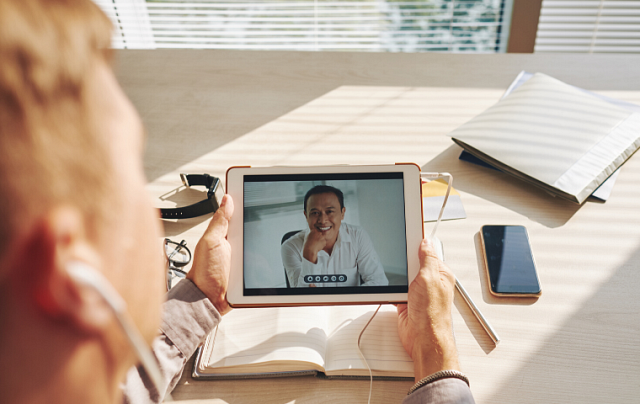Mastering Video Interviews
28th June 2020
One of the things 2020 may be remembered for is the accelerated adoption of video communication in business. One popular provider, Zoom, reported daily users jumped 20 fold to 200 million during the first quarter of the year.
Video interviews are not a new concept but our hiring clients used them fairly infrequently for local recruitment, preferring the in-person approach. But now video is a crucial element of the remote recruitment experience with companies investing in technology to run their hiring processes online.
There's a couple of different video interview styles to be prepared for.
One-Way Interviews
One-way interviews are used for the early stage screening of applicants. It requires you to record your answers to 3 or 4 interview questions. Different software providers have different levels of functionality, but usually, you'll have the option to review and re-record your answers before hitting the submit button.
This method of screening has grown in popularity. It is very convenient for hiring managers because the videos can be viewed at any time, and shared with line managers and other relevant team members.
But they're also great for job seekers as there's a chance to practice your responses and eliminate travel hassles. Unfortunately, you can't ask questions in this one-way format.
Two-Way Interviews
This may be more along the lines of what you expected, it's a real-time conversation between you and the employer. Employers tend not to change up the format from the traditional interview scenario, it just happens over video rather than in person.
For the rest of this blog, we'll share advice which relates specifically to video interview preparation. But we also recommend you take a look at our interview preparation booklet and you'll find this blog helpful if you want to prepare great responses to behaviour style questions.

Tools
From social apps, Facetime and Whatsapp, to business collaboration tools such as Microsoft Teams or bespoke candidate interview software like Willo, Odro or Hinterview, there's a plethora of tools for an employer to choose from.
And of course, each tool is slightly different so it is important that you don't assume you know how it works and carefully follow the instructions. Being careless at this early stage could disqualify you from the recruitment process.
Timing
For one-way interviews you can select the time and place where you take your recording, but employers usually place a deadline on when the video responses should be received by. Get ahead of this as early as you can, not only does it make a good impression but it avoids unnecessary stress if something goes wrong close to the deadline. These types of interviews also have an answer time limit, so it is important you pace your response appropriately and are not cut off mid-sentence. If you receive the questions beforehand, practice your answers, again and again (and maybe even again!). The more familiar you are with your responses, the more natural you will come across.
For two-way interviews, allow plenty of time to get set-up correctly and composed. Don't be on time. Be early.
You'll probably receive the joining instructions, links and passwords via email. Keep an eye on your spam folder, as you know important emails have an annoying habit of ending up in there! Keep this information handy as you don't want to be scrambling around for it minutes before the start time.
Kit
One potential disadvantage to video is that it does require access to the right hardware and software, and this does raise issues for applicants who may worry over the quality of their camera and microphone.
If you really want to get into specifying your interview set-up then our friends at Social Talent wrote this detailed blog on equipment.
We'll assume though that you're taking the interview on a smart phone or you have a webcam on your computer. If this is the case we recommend:
- A tripod to keep your smart phone steady, allowing you to focus wholeheartedly on the interview rather than your hand cramp!
- Have the mic close to you, or use a lapel clip-on mic.
- Ensure the camera is at eye-level and, during the interview, look directly at the interviewer, as if they were in the room with you.
Set-Up
Preparation is key and the best thing you can do is test your set-up with a friend or your recruitment consultant. Some basic steps to ensure you're good to go:
- Good internet connection.
- Devices fully charged, mic and camera switched on and tested.
- Bear in mind that the interviewer will be looking at whatever is around you on the video. While it is important that you be yourself, it would be a mistake to sabotage your interview by not tidying up beforehand. Keep the background as simple as possible so as not to be distracting. The virtual background in Zoom may be a fun feature but it can often make your head look separated from your body!
- Choose a quiet room and ensure everyone in your household knows that you are interviewing for a job and cannot be disturbed.
- Don't sit in the dark. Light on your face is most flattering, so sitting in front of a window is ideal.
- Switch off all other devices so you are not distracted by pinging notifications or calls.
- Record yourself answering some practice questions, the play-back will show you exactly what the interviewer would see and hear, clearly illustrating anything in your set-up that needs to be adjusted.
Dress Code & Presentation
Just because you are on video and the interviewer can only see you from the waist up doesn't mean you don't have to dress to impress. It is important that you take the time to dress smartly. Don't forget, this is still a formal process.
We know interviews are nerve-wrecking but it is more important than ever that you make eye contact, smile, show personality and talk really clearly.
By meeting over video some of the physical cues that you might use face-to-face are diminished, find the balance between speaking and listening and be really aware of your facial expressions and body language.
Oh, and remember, the mute button only turns audio off, it doesn't prevent lip reading!
Question Preparation
Prepare for your two-way interview in exactly the same way as you would if you were meeting in person. It is so important that you come prepared. Research the company thoroughly, have a copy of the job description and your CV to hand. Working with your recruiter, script out answers to the questions you think might come up in the interview and be able to articulately discuss your accomplishments.
A big advantage about being on camera is that you can have prompt cards or notes discretely out of sight but readily available to keep you on track or jog your memory. Definitely have a notepad and pen handy, as the interview progresses these will be really useful for jotting down any questions that you want to ask at the end of the interview.
And Finally, Follow-Up
Once again, the protocol doesn't change because it is a video interview, follow-up with the interviewer to thank them for their time, offering to be available should they require another meeting with you.










